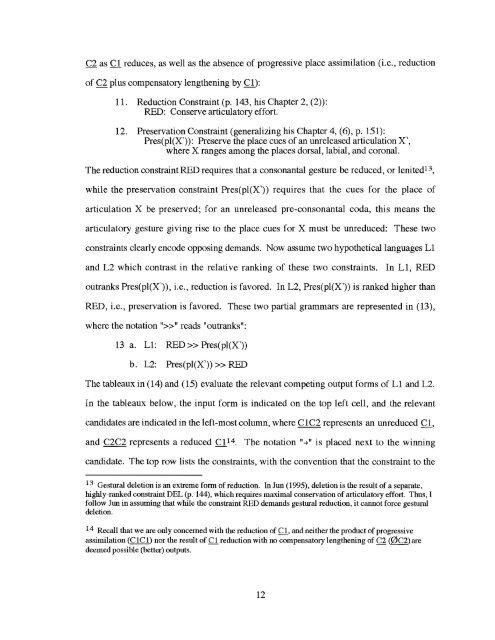A Phonetically-Based Optimality Theoretic Account of Consonant ...
A Phonetically-Based Optimality Theoretic Account of Consonant ...
A Phonetically-Based Optimality Theoretic Account of Consonant ...
Create successful ePaper yourself
Turn your PDF publications into a flip-book with our unique Google optimized e-Paper software.
C2 as C1 reduces, as well as the absence <strong>of</strong> progressive place assimilation (i.e., reduction<br />
<strong>of</strong> C2 plus compensatory lengthening by C1):<br />
11. Reduction Constraint (p. 143, his Chapter 2, (2»:<br />
RED: Conserve articulatory effort.<br />
12. Preservation Constraint (generalizing his Chapter 4, (6), p. 151):<br />
Pres(pl(X'»: Preserve the place cues <strong>of</strong> an unreleased articulation X',<br />
where X ranges among the places dorsal, labial, and coronal.<br />
The reduction constraint RED requires that a consonantal gesture be reduced, or lenited 13 ,<br />
while the preservation constraint Pres(pl(X'» requires that the cues for the place <strong>of</strong><br />
articulation X be preserved; for an unreleased pre-consonantal coda, this means the<br />
articulatory gesture giving rise to the place cues for X must be unreduced: These two<br />
constraints clearly encode opposing demands. Now assume two hypothetical languages Ll<br />
and L2 which contrast in the relative ranking <strong>of</strong> these two constraints. In L 1, RED<br />
outranks Pres(pl(X'», i.e., reduction is favored. In L2, Pres(pl(X'» is ranked higher than<br />
RED, i.e., preservation is favored. These two partial grammars are represented in (13),<br />
where the notation "»" reads "outranks":<br />
13 a. L1: RED » Pres(pl(X'»<br />
b. L2: Pres(pl(X'» » RED<br />
The tableaux in (14) and (15) evaluate the relevant competing output forms <strong>of</strong> Ll and L2.<br />
In the tableaux below, the input form is indicated on the top left cell, and the relevant<br />
candidates are indicated in the left-most column, where CIC2 represents an unreduced C1,<br />
and C2C2 represents a reduced C114. The notation "-+" is placed next to the winning<br />
candidate. The top row lists the constraints, with the convention that the constraint to the<br />
13 Gestural deletion is an extreme form <strong>of</strong> reduction. In Jun (1995), deletion is the result <strong>of</strong> a separate,<br />
highly-ranked constraint DEL (p. 144), which requires maximal conservation <strong>of</strong> articulatory effort. Thus, I<br />
follow JUll in assuming that while the constraint RED demands gestural reduction, it cannot force gestural<br />
deletion.<br />
14 Recall that we are only concerned with the reduction <strong>of</strong> Cl, and neither the product <strong>of</strong> progressive<br />
assimilation (CIC!) nor the result <strong>of</strong> Cl reduction with no compensatory lengthening <strong>of</strong> C2 (0C2) are<br />
deemed possible (better) outputs.<br />
12
















